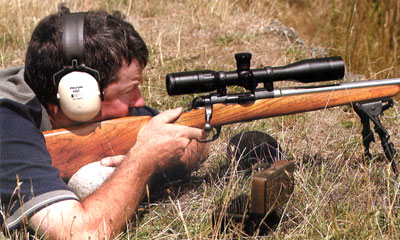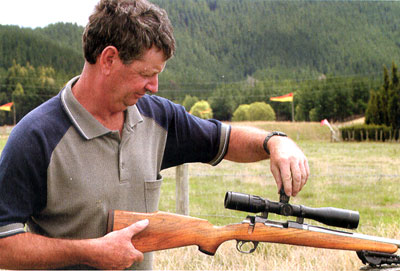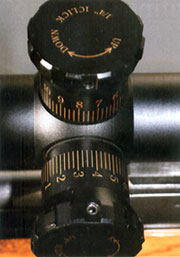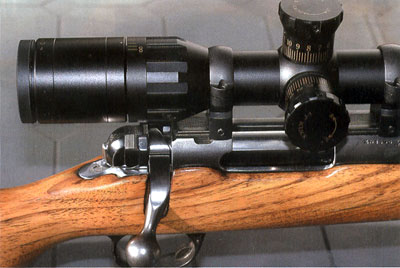
This is a dedicated fixed-power target scope, and a new addition to the Lynx Professional series, aimed at the free rifle NRA shooter. It comes with a choice of either a mil-dot reticule or a one eighth dot with a fine crosshair.
In Australia the NRA free rifle target has a white central bull and the Lynx’s dots fit in the bull perfectly from 300 to 1500 yards. Here in New Zealand our free rifle shooters use the same NRA targets as the aperture sighted shooters on the mound, so either reticule would work okay. Our test scope had the fine crosshair reticule.
 |
Dave uses the high magnification Lynx to score a string of Bull's-eyes at 300 and 900 yards. |
The specifications for the 20x42 target scope are as follows: It comes with a 30mm tube, weighs 630 grams, measures 358mm in length, and is water, fog and shock protected. The tube is one piece (monotube) construction, and all lens surfaces are multi-coated. The diopter adjustment is +1 to -3 and is by means of a rubber ring at the rear of the ocular bell. The eye relief is 98mm, field of view 5.9 feet at 100 yards, exit pupil 2.1.
The parallax adjustment ring is located at the front of the ocular bell, making for a very long housing, and works from 10 metres to infinity. The scope has target turrets with a click value of 1/4 MOA. There are 85 minutes of Angle of windage adjustment and 95 MOA of elevation adjustment. The finish is an attractive satin black and the scope is a compact unit for the magnification. A sunshade measuring approx. 150mm is included in the package.
I fitted this scope to the integral dovetails on my .223 BSA rifle using medium height 30mm Lynx mounts provided by the agent, and used a Bushnell boresighter to bring the reticule somewhere near zero.
Considering its small exit pupil of 2.1, the scope is clear and fairly bright during full daylight hours. The optics compared well against my 10x42 Leupold in good light. The focus adjustment is critical to achieve a sharp image at all ranges, as is to be expected with an optic of this magnification. All adjustments are smooth without free movement, but I did find that the detents on the windage and elevation turrets needed a delicate hand as they were very light to adjust.
 |
Reticle adjustment is precise, but light detents mean that care must be taken to get things right. |
As the accompanying photos show, the scope was mounted as far forward as it could be on the BSA, with the rear mount right at the front of the rear receiver bridge, and the scope ocular housing right up against the mount.
The 98mm eye relief is critical, and on this particular rifle it meant that the shooter’s face was too far back along the stock to get a comfortable sight picture when he was laying down in the prone shooting position. Other makes of rifles will have more room for adjustment that the little BSA, and a Weaver type rail would probably solve any mounting difficulties.
I phoned up Dave Dick, a NRA full bore shooter and also a keen hunter, who has plenty of experience with both scopes and target shooting, to ask if he would like to put the 20x42 Lynx through its paces at our local 900 metre Kaituna NRA range. “Sure!” said Dave, “We have a practice day in two weeks.” I arranged for him to pick up the rig promptly, to allow him time to sight it in and familiarize himself with the rifle and scope combination prior to the test.
The day in question turned out to be fine and sunny, but with an inconsistent westerly wind of about 20kph blowing. For sighting-in purposes I had given Dave a supply of my 55 grain Hornady V-Max varmint reloads that I know to be accurate performers in this rifle, and for range use, some 75 grain A-Max match Hornadys loaded with 24 grains of ADI Benchmark 2. The brass consisted of benchrest prepped Norma .223 cases. This is my pet free rifle load that has proven very competitive in the past.
 |
The 20x42 has 1/4 minute of angle (MOA) click stops, with plenty of windage and elevation adjustment available. |
Dave showed me some pretty impressive groups he had shot while sighting-in the rig. He also commented on the critical eye relief of the scope and the impossibility of moving it any further forward on the BSA. In consequence he had to shoot from an uncomfortable position with his head too far back, but this did not prevent him from shooting ten bull’s-eyes at 900 yards once he was on the mound.
Dave feels that the Lynx would be a good entry level scope for full bore, with the proviso that such a powerful scope is not everyone’s cup of tea for that discipline, something I heartily concur with, as my full bore free rifle scope of choice is just 10 power.
He also found that the focusing for the parallax was very critical to achieve a clear image at all ranges because of the scope’s high magnification. However, once it was exactly focused, he liked the fine crosshair and the clean contrasty image it provided despite the relatively small exit pupil of 2.1. Dave also found that the turret adjustments were precise and returned well, while noting that the detents for the clicks were quite light and needed care when he was altering the aiming point.
 |
The Lynx is a nicely finished scope with clear markings. The parallax adjuster is set into the rear (ocular) lens housing. |
As with all very high magnification scopes, mirage was evident even on this cool autumn day, which could be a problem on a really hot mid-summer day.
Dave felt that the Lynx was a well made scope, and he used it to reduce the varmint population while he had the rifle in his possession, although he commented that with its high magnification and narrow “target” field of view, it was sometimes hard to find them in the scope. Lynx does make excellent varmint scopes, but this particular model is not really designed for that purpose.
My impression of the Lynx 20x42 is that it is a good quality product. You just need to be sure that you need that much magnification for your type of shooting.
Erin Boyd
Text and photography by Erin Boyd- New Zealand Guns & Hunting- Jan-Feb, 2007